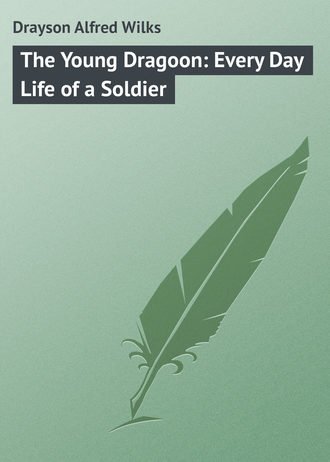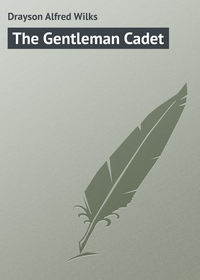 полная версия
полная версияThe Young Dragoon: Every Day Life of a Soldier
The 8th Hussars landed in India, in 1802, from the Cape of Good Hope, and the following year the corps was actively engaged, under Lord Lake, against Scindia and Holkar, in the restoration of the Peishwa to his dominions. It served at the siege and capture of Agra, when an immense quantity of treasure, guns, ammunition, and stores were captured. Afterwards Lord Lake, with his cavalry, rapidly pursued Scindia’s army, and caught it at Leswarre, where the 8th behaved with great gallantry, frequently charging and fighting most successfully, hand to hand, with the enemy until our own infantry came up, when a complete rout ensued, and forty-four colours, with seventy-two guns, were captured. The result of this brilliant and hard-contested battle, was the overthrow of the power of Scindia, who sued for peace, and the 8th received the honourable distinction of the word “Leswarre” on their appointments.
In 1804, the regiment was again in the field under Lord Lake against Holkar, and, in pursuit of his army from Delhi, marched a distance of 400 miles in eighteen days, and by this rapid march saved Furruckabad from being sacked by the enemy. Lord Lake, in his public despatch, wrote in very high terms of Lieutenant-Colonel Vandeleur and the 8th Hussars (then Light Dragoons) for the rapidity and gallantry displayed in their vigorous charges. They afterwards proceeded with the army to the capture of Deeg, and were again publicly eulogised by Lord Lake for their gallant services. In 1805 the regiment was employed in covering the operations of the siege of Bhurtpore, being detached with other troops in search of a body of the enemy under Meer Khan. When arriving at Putghaut, the 8th swam the river Ganges, and subsequently found the enemy in order of battle at the foot of the Ufzulghur Hills, when two regiments of cavalry charged, with the 8th in support. The charge could not take effect at first, on account of a deep nullah being between our troops and the enemy’s front, when a squadron of the 8th, under Captain Deare, made a détour to the left, and by a dashing and well-timed charge on the right flank of the enemy, put them to flight, rescued a troop of Bengal Horse Artillery, and captured all the enemy’s standards.
The regiment then continued on active service with Lord Lake’s army, pursuing the enemy to the banks of the Sutlej, where a treaty of peace was concluded with Holkar.
In 1808, the 8th took the field under command of Lieutenant-Colonel Robert Rollo Gillespie, but soon returned to quarters, on the submission of the Sikhs.
From 1812 to April, 1813, the regiment was employed against the Pindarees, after which it went into quarters at Meerut.
In 1814 the corps was again called upon to take the field against the Ghoorkas of Nepaul, a squadron being attached to the division commanded by Major-General Sir Robert Rollo Gillespie, on whom devolved the task of forcing a passage into the Deyrah Dhoon. The troops entered the pass on the 25th of October, and commenced the siege of Kalonga, a fort on the top of a steep hill near Deyrah. On the 31st of October, an attack was made by storm, but failed; when, in the absence of any other reserve, the squadron of the 8th was dismounted, and, headed by General Gillespie himself, was led to the attack of the fort. They penetrated through the first stockade, cleaving their way through the dense masses of the enemy with their sabres, and a few actually got into the fort, but for want of further support were finally repulsed. General Gillespie himself was killed, and all the officers, four sergeants, and fifty-one men being wounded out of the squadron of one hundred sabres. After this, the fort was besieged in form, and held out gallantly for a month, but was then evacuated by the Ghoorkas. The regiment next assembled at Saharunpoor, and formed part of the Army of Observation near Delhi, to overawe the Mahratta Chiefs, during the rest of the Nepaul war. Early in 1817, the 8th was present at the siege of Hattrass, and returned to Meerut. In October of the same year, the corps again took the field, under Major-General Donkin, against the Pindarees. After forced marches for several days, they came up with the enemy, and totally routed them. In 1820, the 8th marched to Cawnpore, relieving the 11th Light Dragoons (now the 11th Prince Albert’s Own Hussars), and remained at this station until 1822, when, after an absence of twenty-seven years from Europe, twenty of which it passed under the burning suns of India, the regiment returned to England. His Excellency the Governor-General issued the following order, on the embarkation of the regiment: —
“Fort William, December 6, 1822.
“On the occasion of the approaching departure of His Majesty’s 8th, or King’s Royal Irish Light Dragoons, from India, the Most Noble the Governor-General in Council feels himself called upon, and eagerly answers the call, to express the high sense entertained by Government of the eminently valuable services of the regiment during a period of twenty years in this country. Their career has been marked by everything which can distinguish a cavalry corps. A decided spirit of energy has always illustrated their conduct in the field, where they have invariably exhibited to their fellow-soldiers an example peculiarly worthy of imitation. A cordial unanimity has likewise subsisted between the officers and men of the regiment, and their brethren-in-arms of the Honourable East India Company’s service, who, doubtless, will long cherish the remembrance of a corps as much distinguished for their social qualities and orderly conduct, as for that high principle of military feeling which has so decidedly marked the character of the King’s Royal Irish Light Dragoons.
“Signed W.L. Watson, Deputy Adjutant-General.”
The regiment embarked at Calcutta on the 11th January, 1823, and landed at Gravesend in the following May.
The year 1857 will long be remembered by all taking an interest in military matters, for the breaking out of the Indian mutiny, during which the bloodthirsty Sepoys, under that incarnate fiend Nana Sahib, massacred a number of the wives and children of our officers and soldiers, and cast their bodies into a well at Cawnpore.
No sooner was our army withdrawn from the Crimea, than several of the effective regiments were embarked for active service in India, in order to bring the rebels to submission. The 8th King’s Royal Irish Hussars were at once despatched, and they landed at Bombay, December 17, 1857. In January, 1858, the corps re-embarked, 490 strong, besides commissioned officers, all well mounted and in first-class fighting trim, for Mandéree, in Cutch, and proceeded by rapid marches to join Sir H. Roberts’ Rajpootana Field Force at Kotah, where it arrived the day before the place fell. Afterwards the head-quarter wing was detached, under Brigadier Smith, to cover the rear of the Central India Field Force, and co-operate with Sir Hugh Rose. It swept the Shahapoor jungles of the disaffected, and then recaptured Chundaree, which the rebels had occupied a second time upon Sir Hugh Rose’s advance to Calpee. Smith’s Brigade reached Kotah ka Serai, near Gwalior, the day after Sir Hugh Rose had taken Morar, and was hotly engaged the same day and three following days, ending on the 20th of June, 1858, in the capture of the town and fort of Gwalior. On the first of the above days a squadron of the 8th (98 sabres) charged right under the guns of the fort of Gwalior into the centre of the rebel camp, completely routed it, and brought away two guns. During the panic that ensued the Ranee of Jhansee lost her life. This woman was known to be one of the most active instigators of the rebellion, and up to this period had always accompanied the rebels in their marches and engagements. The brigade to which the 8th were attached now marched to Seepree, but on the 3rd August, the rebel Rajah Mann Singh seized the fortified town of Powrie, near Seepree. The brigade immediately invested it, and was afterwards joined by another force under Sir R. Napier, when the fort was captured on the 22nd August, a portion of the 8th being dismounted and taking part in the siege. Soon after this a squadron of the 8th, attached to Colonel Robertson’s Flying Column, caught the rebels at Beejapore, near Goonah, September 5, 1858, and inflicted heavy loss upon them. Meantime, the left wing of the regiment, under Brigadier Honner, were following the rebels under Tantia Topee, and caught them at Kotarrhea, on the Bunnass river, thirty-five miles north of Ooderpore, when, by a dashing charge, they completely broke up the infantry force, and drove the remainder, after a long pursuit, across the Chumbul.
A troop of the 8th accompanied Brigadier Parke in his long-continued pursuit of the rebels, accomplishing at one time 251 miles in eleven days, and by so doing dispersed the rebel force at Ghota Ooderpore, December 1, 1858, and saved Baroda, to which place the ruffians were marching. Smith’s brigade was sent to co-operate with Sir J. Michel, and under him the head-quarter wing of the regiment took a prominent part in the battles of Sindwaha, October 19, and Koorwye, October 25, by which last defeat the rebels were driven south of the Nerbudda river, tracked incessantly by a troop of each wing of the 8th Hussars as far south as Ellichpoor. The head-quarter wing continued operations on the Betwa river, against the much-scattered insurgents, surprising them at Koondrye, near Seronge, December 15, 1858; and again at Boordah, near Muxoodnugger, April 5, 1859, at both which places the regiment destroyed several hundred rebels with the sabre.
Another squadron of the left wing, under Brigadier Honner, went in pursuit of the rebel chief, Ferozeshah, and the insurgents, and, after chasing them into the Bikaneer desert, and thereby saving the capital, turned them south, and caught them, by a rapid pursuit, at Kooshana, near Jhoodpoor, February 10, 1859, killing a large number. The head-quarter wing of the regiment reached Nusseerabad, May 21, 1859, having been incessantly engaged in operations against the rebels, and gone through two hot-weather campaigns since it landed in Cutch, during which time it shifted camp no less than 300 times, and marched over 3000 miles.






